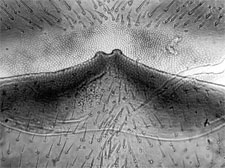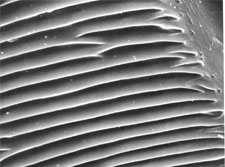Beetle love
 |
How do male and female mountain pine beetle find each other in a pine forest that is hundreds of square kilometres in size? Beetles use both chemical signals and sound to attract one another.
Powerful Perfume: How beetles attract one another with scent
Beetles have a sophisticated chemical language that allows them to communicate. These chemicals are known as “pheromones.” From the host tree, the mountain pine beetle can emit both an “aggregative pheromone” that attracts other beetles to the tree, or they can emit an “anti-aggregative pheromone” that neutralizes the aggregative pheromone. This helps to avoid the harmful effects of having too many beetles on one tree competing for resources.What’s the difference between pheromones and hormones?
Hormones are chemicals that the body produces and releases internally. Pheromones are chemicals that the body produces and releases externally to communicate with other organisms.How do beetles use sound to communicate with one another?
Beetles rub body parts together to create sound. Mountain pine beetle have a “scraper” on their abdomen that they rub against a grooved surface on the underside of their left wing cover to create a sound that is not audible to humans. This is called “stridulating.” Once the female beetles have arrived on a suitable pine tree host, they begin to stridulate and produce aggregative pheromones to attract other unmated males and females. New females arrive and do the same as they land and bore into the tree. As the males arrive, they enter the galleries that the females have tunnelled, and begin to stridulate to let the females know they have arrived, and to also warn others that the female in that gallery is taken. At this point, the female stops producing aggregative pheromones and starts producing anti-aggregative pheromone to deter more beetles from coming. (A) Scraper © Malcolm M. Furniss |
 (B) File © Malcolm M. Furniss |
| Bark beetles of the genus Dendroctonus, including the mountain pine beetle, communicate sonically by means of rubbing a scraper (A) on their abdomen against a file (B) on the inside of their hardened wing cover. The resulting chirping sounds influence mating behaviour. This photo shows the stridulatory mechanism of a related species, the Douglas-fir beetle. | |
Why do mountain pine beetle use aggregative pheromones?
Aggregative pheromones help beetles coordinate an attack of many individuals on a host tree at one time. If only one female beetle were to attack a healthy tree, it is likely she would succumb to the tree's defences and be caught in the sap or “pitch”. However, if many beetles attack the tree at once carrying the blue stain fungi with them, they have a better chance of clogging the tree's defences and reproducing successfully.Love is in the air: how microclimate affects beetle communication
Because beetles use pheromones to communicate, their communication is affected by the “microclimate” or weather around the host tree. Microclimate can vary depending on how far the host pine is from other pines, thereby altering the following factors:- Temperature and light: Trees that are farther apart allow
more solar energy into the area around the tree, which means the temperature
around the tree is higher than in a denser stand. Some research shows that
mountain pine beetle are more likely to land and attack a tree under lower
temperatures and light intensities, similar to those found in a typical
pine stand. However, they tend to keep seeking hosts in less dense stands
that allow more light and heat. The longer the beetles are in flight, the
more likely they are to be eaten by predators, or be very low on energy
reserves when they finally do land and begin colonizing a tree.
- Wind: The larger the spaces between pine trees, the more the wind is able to blow through. This can disrupt the chemical messaging between beetles by dispersing the pheromones. In addition, mountain pine beetles fly more slowly in high winds and have more difficulty staying on course.
In addition to the density of pine trees, microclimate can also be affected by other factors like weather patterns (i.e. warming trends), the smoke from fires, soil moisture, and other forest plants.
Related links
- Date modified :